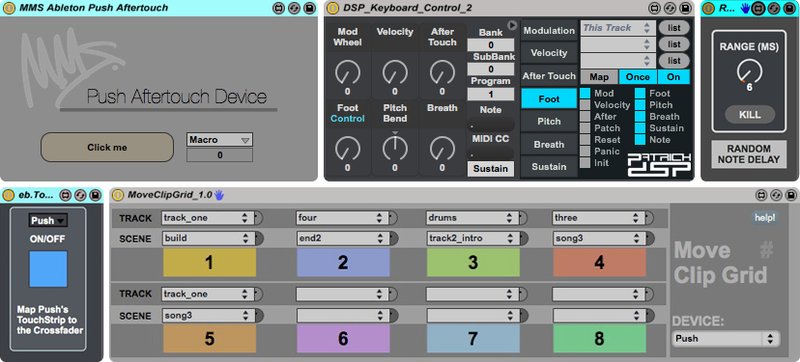Max for Live for Push: A roundup of free devices

As even a cursory glance at the web’s leading online repository of them reveals, there are now so many Max for Live devices available to buy or download for free that it’s hard to know where to begin any investigation into them. To put a figure on it, we’re talking around 2600 at the last count, from instruments and effects to video processors, sequencers and more – although you might need to check compatibility with newer versions of Live and Max for Live for some of the older ones.
Dotted throughout this vast trove of toys and tools are an array of Max for Live devices built specifically to extend the functionality of Push and Push 2, some of which can be yours for the princely sum of nothing. And to save you the considerable time it would take to seek out the best of this gratis bunch, we’ve done the legwork and rounded them up for you…
MIDI and more
When it comes to getting Push to output and manipulate MIDI messages, there are quite a few nifty Max for Live solutions out there, but three of the most useful free ones are Patrick DSP’s Keyboard Control, matthiasmatzer’s Push Aftertouch Device and dedbird’s Putility.
Keyboard Control enables Push’s rotary encoders to fire off a range of standard MIDI data streams, including Mod Wheel, Aftertouch, Pitch Bend and even Breath, as well as triggering Program and Bank changes. Push Aftertouch Device and Putility are rather less complicated, the first using the aftertouch generated by Push’s pads to control any selected Live parameter, the second simply putting Mod Wheel and Aftertouch scaling knobs at your fingertips via Push’s first two rotaries.
Live and direct
There are plenty of Max for Live devices aimed at Push-toting live performers and DJs, and one of our favourites is dataf1ow’s eb.Scrubber. This awesome little freebie calls on Live’s under-the-hood scrub function to facilitate pad-triggered shuttling of the playback head within clips across up to four tracks (independently or as a group), each with its own colour coding. Here it is in action:
Also by dataf1ow, eb.TouchStrip Crossfader assigns Push’s touchstrip to Live’s Crossfader, making for a more physically representative track-mixing experience than you’ll get from a knob.
More hands-on laffs are on the cards with happytosh’s Random Note Delay. This one randomly ‘lags’ the timing of up to 32 incoming notes at once within an adjustable range of 0-127 milliseconds – just the thing for adding a bit of chaos and imperfection to Push’s Note Repeat function.
Handy both on stage and in the studio, Because789’s Parameter Masher gives you the ability to jump instrument, effect and mixer settings around by striking Push’s pads, for crazy on-the-fly transformations and edits. 64 fixed values are assigned to up to eight parameters (eight values per parameter) from throughout Live, with each value dialled in using Push’s rotaries and triggered by a specific MIDI note (ie, pad). As if that weren’t enough, a choice of three Note Off modes determines what happens when the triggering pad is released: the value can either stay put when the Note Off message is received, return to the previous value, or switch to the user-defined ‘Mo2’ value. Deep!
Moving on, if you’re the kind of DJ who likes to run multiple sets within one enormous session, sharp’s Move Clip Grid pro is a no-brainer. Set up eight Session View Push boundary boxes and navigate instantly between them at the flick of a rotary – no more zooming out to the Session Overview to find that crowd-pleaser you were absolutely certain was on Track 37, Scene 62...
Modul8tor’s Push Parameter Slider is another freely assignable control system, handing you centralised governance of up to eight knobs, faders and fields from anywhere in Live. What sets this one apart, though, is that, rather than assign said parameters to Push’s rotary encoders, it employs the eight vertical columns of pads as ‘sliders’. Run your finger up and down each column to raise and lower its target parameter, with the LED backlights following along, or tap a pad directly to transition straight to that value at a speed determined by the Smooth dial (from 0-4000ms).
A feast for the eyes
It was, of course, only a matter of time before someone figured out how to gear Push 2’s high-res full-colour screen up for ‘unofficial’ usage. You may have heard about the recently discovered hack that enables 60fps video to be output over USB to Push 2’s display from Max’s Jitter objects, as demonstrated in Cycling 74’s video:
While we wait to see what direction this intriguing development ultimately takes, we can pass the time performing similar trickery with Push’s fabulously backlit pads. PushIllumination lets you create spectacular multicolour animations and text marquees on that 8x8 bank using the web-based Push Illumination Editor. Check out developer SS4V’s slightly eerie explanatory video:
Pay to play
Before we wrap up, we ought to point out that as well as the free Max for Live devices we’ve looked at here, there are a number of paid-for Push-enhancing gadgets available from various commercial developers, including Sigabort, pp-labs and Isotonik Studios.